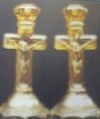Carnival Glass 101 | home Quick Reference to Carnival Glass Patterns on This Site
Northwood - Part 6
NORTHWOOD – Part 6
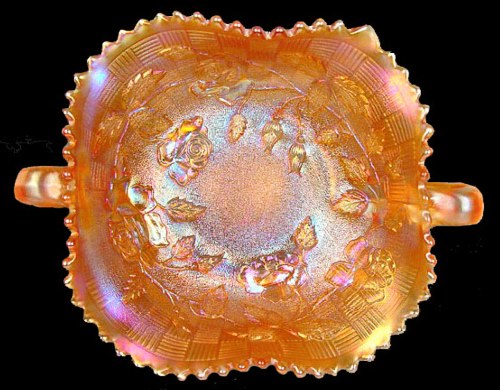
BASKET OF ROSES Bonbon - Stippled
These are also found unstippled.
BASKET of ROSES: There is a special thrill in researching the bon-bon shape, for in many cases, as with this pattern; the design appears only on this shape! Similar to the Fenton Wreath of Roses, closer examination reveals the distinct differences. This is a collar-based, two-handled bonbon, while Wreath of Roses is found on a stemmed bonbon, having a rose in the center with Wide Panel exterior. Most Basket of Roses examples carry the N. trademark. The background may be stippled or plain and the exterior design is Basket weave.
Another very important difference: rarity and value. Wreath of Roses is readily available, while this bonbon is rare in any color! A realistic guess is that fewer than 50 examples exist in Marigold, Amethyst or Cobalt Blue. Certainly a green or white one is not out of the question, so keep your eyes focused for the prize! You just might find one of those. Click on ~~ ~~ in our Alphabet to be taken to view an amethyst Basket of Roses.
~~ in our Alphabet to be taken to view an amethyst Basket of Roses.
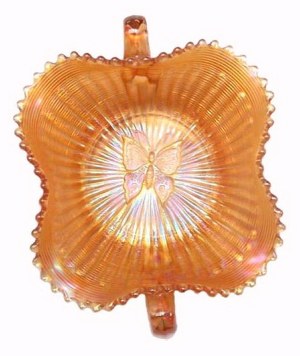 |
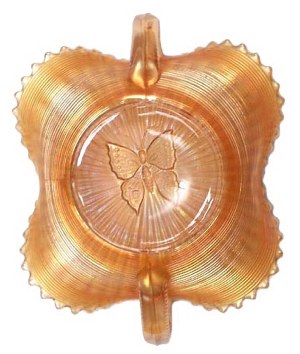 |
BUTTERFLY with Threaded Ext.
|
Threaded Exterior of BUTTERFLY Bonbon.
|
BUTTERFLY: Those with plain exterior: marigold, amethyst, green, smoke. Threaded exterior examples: marigold, amethyst, green, cobalt blue, ice blue. Again, this pattern is exclusive to the bonbon shape!
1910, Northwood introduced this simplistic design of the Butterfly against a Stippled Rays background. The plain backed version is not terribly difficult to locate, excepting green, along with the very rare smoke which is an unusual color from Northwood. Threaded back bonbons in any color are quite scarce, in other than amethyst, which turns up occasionally. Relatively few green examples offer themselves and the ice blue ones are extremely rare, requiring heavy cash outlay. Existence of the ice blue examples confirms production extended into 1912 when Northwood introduced their pastel colors. (Click on ~~ ~~ in our pattern index to view a threaded ice blue bonbon.) No ice green or white examples have yet been reported, but they could be hidden somewhere out there!
~~ in our pattern index to view a threaded ice blue bonbon.) No ice green or white examples have yet been reported, but they could be hidden somewhere out there!
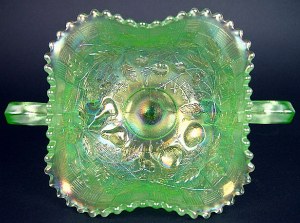 |
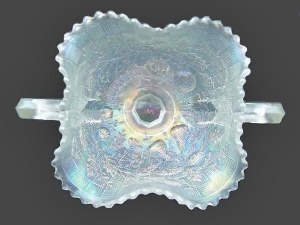 |
No question about the color! Lime Green it is on this FRUITS & FLOWERS Bonbon.
|
FRUITS & FLOWERS
Bonbon in White
|
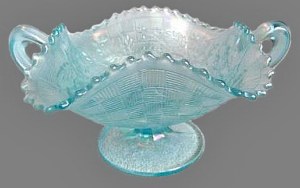 |
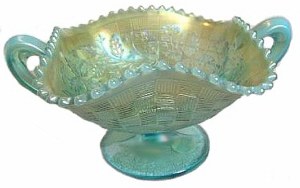 |
Northwood FRUITS & FLOWERS Bonbon in Ice Blue
|
FRUITS & FLOWERS
Bonbon in Aqua Opal.
|
FRUITS & FLOWERS: Stemmed, two-handled, plain examples of these bonbons are found in marigold, amethyst, green, cobalt blue, white, ice blue, ice green, lime green, russet (olive green), clambroth, lavender, smoke, teal, aqua opalescent, sapphire blue, ice blue opalescent. Stemmed, two-handled, stippled: marigold, green, cobalt blue, Renninger blue.
Addition of small blossoms secured into the pattern, separates this design from the familiar Three Fruits pattern. Bowls of varying sizes, 9” flat plates, and hand-grip style plates are also known in this pattern. Perhaps these stemmed bonbons are a favorite shape. Marigold, amethyst, green and cobalt blue do not present much difficulty to locate. Other colors present a challenge. Production of this bonbon shape extended over a good many years from 1910-1911 to 1919-1920, confirmed by existence of their exclusive russet color which came late in the era. A rare Sapphire bonbon may be seen when clicking on ~~ ~~ in our pattern alphabet on the homepage.
~~ in our pattern alphabet on the homepage.
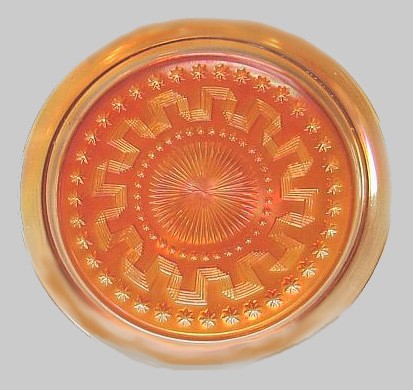
HOLIDAY Tray - 11 in. diameter
HOLIDAY : This tray was often marketed as an under-tray for water sets and liquor sets. Found on rare occasions in crystal or this very rare marigold color, Holiday is a carry-over pattern from the pre-iridescent production. The tray appears in company with a Grape and Cable wine set in a Spring 1912 Butler Brothers wholesale catalog. May be viewed in our: Grape & Cable – Part 1 segment.
Marigold is the only color reported. Most examples bear the Northwood trademark, and while they do not command much money, these iridized examples of the 11” tray should be considered quite rare indeed! We do not believe we have ever seen one sell in a carnival glass auction. We have seen only one marigold tray for sale in an antique mall over all our years of search. John Resnik would call them “a rare-so-what!”
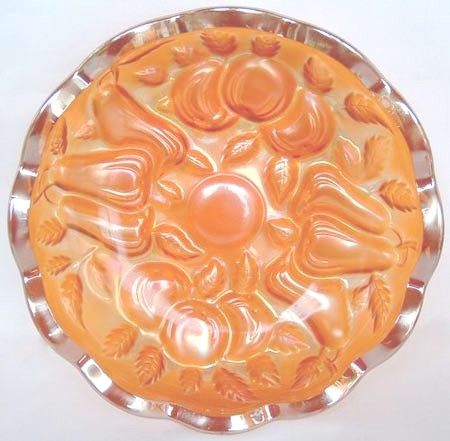 |
|
INTAGLIO APPLE and PEAR-10.5 in. diameter- sold for $75.
|
|
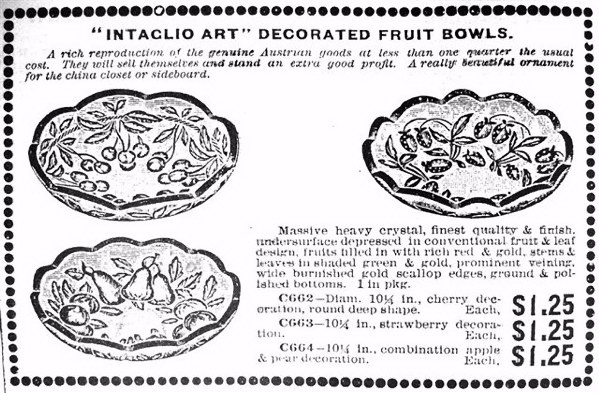 |
|
Spring 1908 Butler Bros. Wholesale Catalog.
|
|
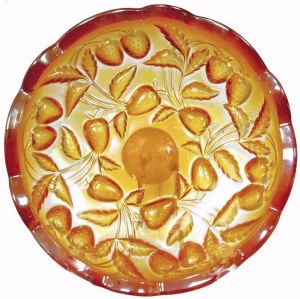 |
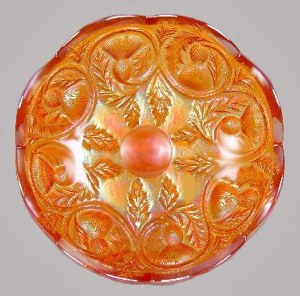 |
INTAGLIO STRAWBERRY
10.25 in. diameter
|
INTAGLIO THISTLE
10 in. diameter
|
INTAGLIO LINE: Pre-iridescent production from the Northwood Intaglio line, circa 1905-1908 is verified by the Butler Bros. wholesale catalog ad from Spring of 1908. Collectors today call these decorated red/gold painted examples, “goofus glass”. Patterns offered in these intaglio pieces are deeply impressed onto the underside, rather than in raised relief on the inner surface.
We lack the Intaglio Cherry pattern here, but these pieces are seldom seen today, indicating a short production run in the iridized form. Iridescent production, circa 1908-1909 was to gain a quick share of the new market for carnival glass while other designs more appropriate to iridescent ware could be developed. 10” ice cream shape master berry bowls and 4 ¾” ice cream shape small berry bowls in marigold are the extent found in this Intaglio Line. They are quite heavy at nearly ½” thick and most are unsigned.
Dean & Diane Fry – 7-07
 |
|
Now when Jesus heard that John had been put in prison,
He departed to Galilee.
And leaving Nazareth, He came and dwelt in Capernaum,
which is by the sea,
in the regions of Zebulun and Naphtali,
that it might be fulfilled which was spoken by Isaiah the prophet,
saying: “The land of Zebulun and the land of Naphtali,
by the way of the sea, beyond the Jordan, Galilee of the Gentiles:
The people who sat in darkness have seen a great light,
and upon those who sat in the region and shadow of death Light has dawned.” From that time Jesus began to preach and to say,
“Repent, for the kingdom of heaven is at hand.”
Matthew 4:12-17
|
|
 |
Should you care to contact the Frys, their email address is:
Search Our Sites
back to Carnival Glass 101
Our other sites you may enjoy:
Everything you EVER wanted to know about Indiana Glass
Great Reference for Newer Carnival Glass.
Complete Glassware Catalogs Available to Download
Questions? Comments? Suggestions? Broken Links? Corrections?
Your Friendly Webmaster is here to help!
